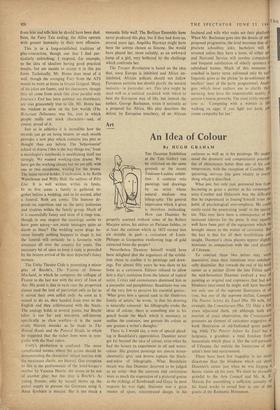Art
An Idea of Colour
By HUGH GRAHAM Nevertheless Daumier himself would have been delighted that the organisers of the exhibi- tion chose to confine it to paintings and draw- ings. For almost fifty years he was slave to his fame as a cartoonist. Editors refused to allow him a day's remission from the labour of topical satire. Critics and connoisseurs dismissed him as a journalist and pamphleteer. Baudelaire was one of the very few to perceive his essential genius: 'What gives him a special rank in the illustrious family of artists,' he wrote, 'is that his drawing is naturally coloured: his lithographs evoke the ideas of colour; there is something else in his pencil beside the black which is necessary to outline the contours; one guesses his colour as one guesses a writer's thoughts.'
There is, I would say, a note of special plead- ing in Baudelaire's appreciation. Daumier never got far beyond the idea of colour, even when he had the leisure to experiment in oil and water- colour. His greatest paintings are almost mono- chromatic; grey and brown replace the black- and-while of lithography. What Baudelaire meant was that Daumier deserved to be judged as an artist--that the cartoons and caricatures were as much the expression of a pictorial genius as the etchings of Rembrandt and Goya. In most respects he was right. Daumier was a great master of spare, concentrated design, in his cartoons as well as in his paintings. He under• stood the dramatic and compositional possibili' ties of chiaroscuro better than any of his coo' temporaries, with the exception of Courbet. His quivering, nervous line gave vitality to every' thing which it described.
What just, but only just, prevented him from becoming as great a painter as his contempor- aries Courbet and Delacroix was the difficulty that he experienced in freeing himself from the habit of psychological over-emphasis. He could • rarely resist the penetrating 'aside' to the specta• tor. This may have been a consequence of his' incessant labours for the press. It may equallY well have been part of the equipment which he brought innate to the matter of cartoonist. But the fact is that for all their truthfulness and insight, Daumier's chess players appear slightlY histrionic in comparison with the card players of Cdzanne.
To contrast these two artists may scent insensitive, since their intentions were antitheti- . catty dissimilar. But towards the end of his brief career as a painter (from the late Fifties until the mid-Seventies) Daumier evolved a way of painting so original and expressive that had not blindness intervened he might well have become not only one of the supreme illustrators of all time, but one of the supreme stylists. Compare The Painter before his Easel (No. 50) with, for example, the Connoisseurs (No. 53). Only a fey/ years separated them, yet although both are marvels of exact observation, the Connoisseurs possesses an element of caricature suggestive of book illustration or old-fashioned genre paint- ing, while The Painter before his Easel has a largeness, a grandeur, a total freedom from inessentials which place it, like the self-portraits of Cdzanne, far outside the limitations of the artist's time and environment.
There have been few tragedies in art more disastrous than the blindness which cut short Daumier's career just when he was forging a heroic vision all his own. We must be eternally grateful to the Arts Council and Mr. K. F. Maison for assembling a sufficient quantity of his finest works to reveal him as one of the giants of the Romantic Movement.


































 Previous page
Previous page